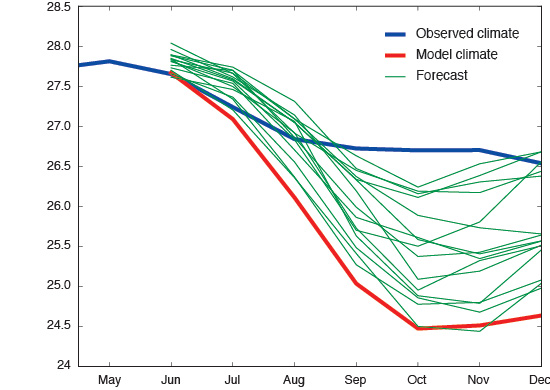...
In that sense, even though seasonal forecasts share some method and tools with weather forecasting they are part of a different paradigm which requires treating them in different ways. Seasonal forecasts instead of trying to answer to the question "how is the weather going to look like on a particular location in an specific day?", they will tell us how likely is that the coming season will be wetter, drier, warmer or colder than normalthe usual conditions for that time of year. This kind of long term predictions are feasible due to the behaviour of some of the earth system components which evolve more slowly than the atmosphere (e.g. the ocean, the cryosphere) and in a predictable fashion, so their influence in the earth system can add a noticeable signal.
We consider here as seasonal forecasts data both the outputs of higher-frequency (sub-daily and daily) data outputs from numerical earth system weather or climate models and the derived monthly and seasonal products, up to a few months ahead of their initialization date.
...
The C3S seasonal forecasting products are based on data from several state-of-the-art seasonal prediction systems. Multi-system combinations, as well as predictions from the individual component systems, are available. The centres currently providing forecasts to C3S are ECMWF, The Met Office and Météo-France; in the coming months data produced by Deutscher Wetterdienst and Centro Euro-Mediterraneo sui Cambiamenti Climatici will be included in the C3S multi-system.
Each model simulates the Earth system processes that influence weather patterns in slightly different ways, leading to different kinds of model error. The accumulated model errors become significant in comparison to the signal that is meant to be predicted. Some of those errors are shared by the different models but others are not, so combining the output from a number of models enables a more realistic representation of the uncertainties due to model error. The current scientific knowledge have shown that, in most cases, such combined forecasts are more skilful than forecasts from the best of the individual models.
Currently, there are graphical products available in the C3S web site and public access to the data is provided via the ECMWF WebAPI. From 2018 onwards, C3S seasonal forecast data products will be made available via the C3S Climate Data Store (CDS).
Seasonal forecasts are not weather forecasts: the role of the hindcasts
Due to its long leadtimes, a few months since the start date of the forecast, some systematic errors appear that can completely kill the signals that are expected to be predicted. To avoid that, seasonal forecasting systems work with a reference climate to determine how predicted values differ from what is normal for a given region and time of year. The same forecast system is run for past dates, so that kind of model climate can be estimated, and the forecasts be bias-corrected with respect to that model climate. Those forecast runs for earlier years are known as 'hindcasts' or 're-forecasts' and they are a key concept in seasonal forecasting, in such a way that a forecast itself it's not useful without relating it with the relevant hindcasts.
In the image shown below as an example of the crucial role of the hindcasts in seasonal forecasting, a time evolution of monthly average of temperature in a given region is plotted. All the forecast ensemble members (green lines) seem to point to colder than usual conditions when directly compared to the observed climate (blue line). If the model climate derived from the hindcasts (red line) is taken into account the conclusion is quite different, with all the forecast ensemble members now consistently pointing to warmer than usual conditions.
Additionally to their unavoidable role to correct those systematic errors, hindcasts are also used to assess the skill of the different seasonal forecasting systems. In that way, the real-time forecasts are expected to behave with the same skill that the system has shown for past dates, i.e. the skill shown by the hindcasts.
Note that for reasons related with the availability of computing resources, the hindcasts usually have fewer ensemble members per start date than the real-time forecasts, e.g. ECMWF SEAS5 5 has 51 members for the real-time forecasts, and just 25 members for the hindcasts.
How the seasonal forecasting systems build their ensembles?
...
